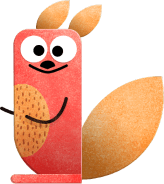

High-pitched and low-pitched
The children imitate the flight of bees as they move around close to the ground or up in the air in response to low-pitched or high-pitched sounds.
Discovering the different vocal registers of women and men: the children explore high- and low- pitched sounds by listening to musical pieces sung by a woman and a man.
The children talk about their snacks and explore the concept of sound pitch with Mazaam’s squirrels.

Slow tempo and fast tempo
The children place a token into a box correspondingto the tempo of the music they hear (fast or slow).
The children find out about slow and fast tempos by imitating butterflies trying to avoid being eaten by chameleons
The children brush the chameleons’ teeth to music, and revisit the concept of slow and fast tempo.

Loud sounds and soft sounds
Discovering different levels of musical intensity. The children use pictograms of lynx to explore loud and soft sounds in music.
Let’s explore different levels of musical intensity. We’ll use loud and soft sounds to guide a detective to find a hidden object.
The children find the lynx’s lost toys by counting the number of loud sounds they hear in the music.
The children try to find the toys and toy box belonging to the Mazaam lynx and learn how to categorize objects.
The children perform a musical massage and explore the concept of the intensity of sounds.
The children learn to distinguish the intensity of sounds by passing bells as silently as possible from one classmate to another.
The children imitate the flight of bees as they dance to the intensity (loud/soft) of the sounds they hear

Wind instrument and string instrument
The children find out about the families of musical instruments by using the Mazaam app and a game of musical seek-and-find
The children explore the various timbres of wind and string instruments as they imitate the motions of the musicians playing them.
The children learn to differentiate the different timbres of string and wind instruments by talking about the instruments they know.
The children learn to distinguish the different timbres of string and wind instruments by playing a musical version of the game Simon Says.
As the children play timbre-ball, they learn to distinguish the timbre of string instruments from that of wind instruments.

Consonant sounds and dissonant sounds
The children make up a story based on the music and then act it out together.
The children discover their musical preferences and discuss the importance of respecting everyone’s individual tastes.
The children learn how to recognize the difference between consonant and dissonant sounds by using pearls to explore the concept of harmony.
By setting up an obstacle course, the children improve their understanding of the concepts of consonance and dissonance in music and develop their musical preferences.
The children learn to recognize the difference between consonant and dissonant sounds by feeding Mazaam’s sea lions.


Mazaam would like to thank the Government of Canada for their financial implication through their Creative Export Canada initiative
Mazaam Interactive Inc. © 2021. All rights reserved. Policy Privacy

